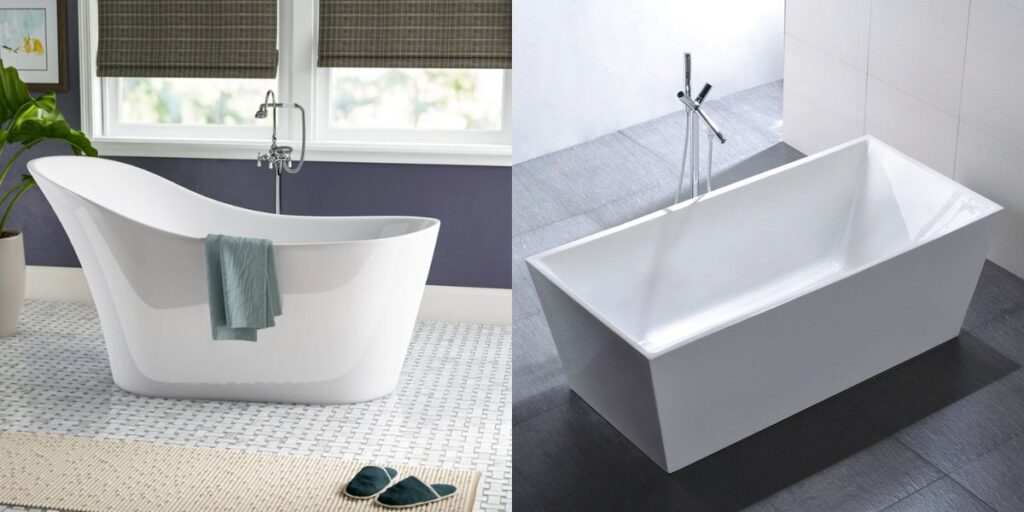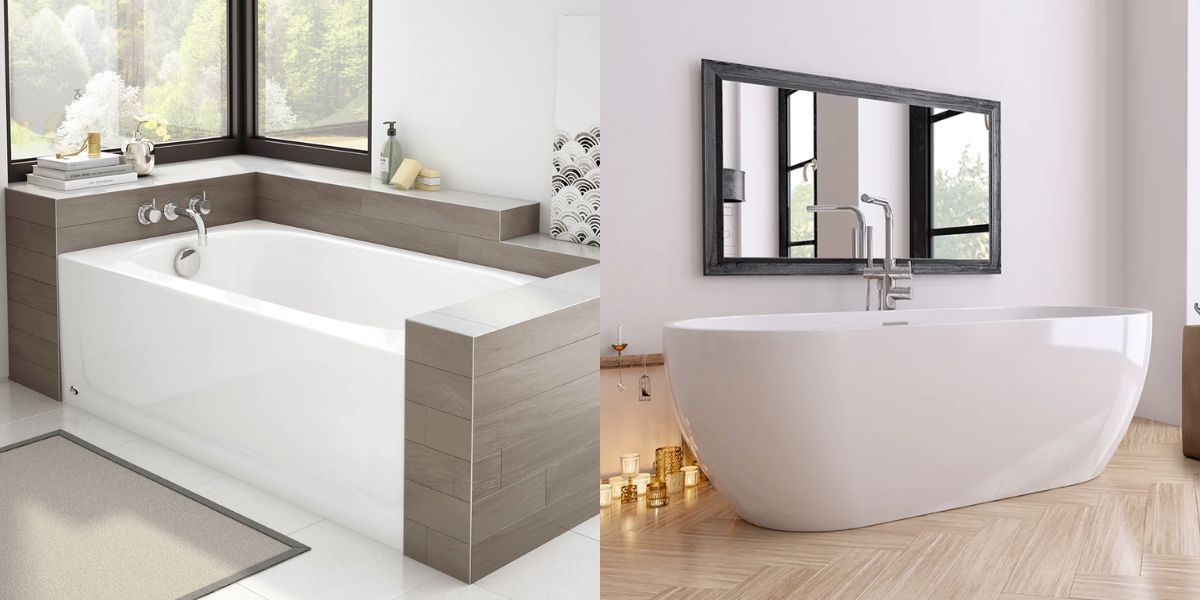Acrylic vs Porcelain Bathtubs: Which One Is Best For You?
Well, both offer great durability, styling, and functionality for your bathroom, but there are some key differences between acrylic vs porcelain tubs that are worth considering before making your final decision. So, I’ll break down the pros and cons of acrylic and porcelain bathtubs to help you determine which is best for your needs and budget.
I’ve remodeled a few bathrooms over the years, and I’ve had the experience of installing both tub types. I can say from firsthand experience that acrylic and porcelain each have their advantages and disadvantages when it comes to factors like durability, cost, cleaning needs, style options, heat retention, installation, and more. By weighing these pros and cons, you can zero in on the right tub material for your space.
Key Differences Between Acrylic and Porcelain Bathtubs:
| Feature | Acrylic Bathtub | Porcelain Bathtub |
|---|---|---|
| Durability | Less durable, prone to scratches and stains over time | Extremely durable, scratch and stain resistant |
| Cost | More affordable, starting around $300-400 | More expensive, starting around $500-600 |
| Cleaning | Requires gentle cleaning with non-abrasive products | Can be cleaned vigorously with abrasives |
| Style Options | Many colors and styles like jetted or air tubs | Mostly classic white or biscuit colors |
| Heat Retention | Does not retain heat as effectively | Excellent heat retention for soaking |
| Installation | Lightweight for easier DIY installation | Heavy, often needs professional installation |
| Lifespan | 10-15 years on average | 20+ years with proper care |
| Best Suited For | Kids’ or guest bathrooms | Master bathrooms |
How Durable Are Acrylic vs Porcelain Bathtubs?
One of the first things most shoppers want to know is how durable and long-lasting their bathtub will be. After all, your tub sees a lot of use and needs to stand up to the test of time.
Acrylic tubs are plenty durable for the average homeowner’s needs. High-quality acrylic is rigid and impact-resistant. With proper care, an acrylic tub can last 10-15 years or more before needing replacement. However, acrylic is softer than porcelain enameled steel, so it does tend to scratch and stain a bit more easily over time. Minor scratches can buff out, but deep scratches are permanent.
Porcelain enameled steel tubs on the other hand are extremely durable and built to last. The glass-like porcelain enamel finish is essentially scratch-proof and highly resistant to staining. These tubs have no problem standing up to kids, pets, and heavy use for 20+ years.
You can vigorously scrub a porcelain tub without worrying about causing any real damage. Their durability is why porcelain tubs have been a tried-and-true choice for generations.
So in the porcelain vs acrylic bathtub durability matchup, porcelain is the clear winner. But acrylic tubs are still durable enough for most homeowners’ daily use. Just take care to avoid gouging acrylic surfaces with sharp objects or abrasive cleaners.
Read more about: Do Acrylic Bathtubs Need Insulation?
What’s the Cost Difference Between Acrylic and Porcelain Tubs?
Another major factor in choosing a tub material is the cost, since bathtubs can range widely in price. In general, acrylic tubs cost less than porcelain tubs. You can find acrylic alcove tubs starting around $300-400, whereas porcelain usually starts around $500-600. The price goes up from there depending on size, features, brand, etc.

Porcelain tubs are considered a premium bathtub option, given their reputation for quality, durability, and luxury feel. So you can expect to pay a higher price for this tub type. Cast iron porcelain tubs in particular are very heavy and costly to produce. However, many homeowners think the added durability and aesthetic of porcelain justifies the investment over cheaper acrylic.
If keeping costs down is your top concern, acrylic tubs provide quality and functionality at a more budget-friendly price point. Just don’t expect acrylic to have quite the same flawless, glossy look and luxurious feel as real porcelain. So weighing cost vs benefits helps inform which material is the better value for your bathtub needs.
Cleaning and Maintenance Needs for Acrylic vs Porcelain
To keep any bathtub looking pristine, you need to clean and care for it properly. So what are the cleaning demands for acrylic vs porcelain tubs?
Acrylic has a non-porous surface that makes it relatively easy to clean with proper care. Use a soft cloth or sponge with mild liquid soap or an acrylic-safe tub cleaner. Avoid abrasive cleaners, scouring pads, and scrub brushes that could scratch the softer acrylic surface. Mildew can also be an issue if moisture is allowed to linger. Make sure to squeegee and wipe down your acrylic tub after each use.
Porcelain enamel is less prone to scratching and staining, so you can clean it more vigorously than acrylic. Use bathroom cleaners and tools containing abrasives like Comet, Ajax, etc. The porcelain surface can handle vigorous scrubbing without damage. Just avoid harsh chemical drain cleaners sitting on the surface too long. Porcelain tubs are also less prone to mildew buildup.
Overall, porcelain tubs require a bit less daily maintenance to keep looking like new. But acrylic only needs light cleaning and care to maintain its appearance. Just don’t abuse the softer acrylic with heavy scrubbing.
Read more about The Key Differences Between Acrylic and Fiberglass Bathtubs
What Style and Design Options Exist for Each Tub Type?
Besides performance, the aesthetics and style selection for tubs could impact your decision between acrylic vs porcelain. What design varieties are available?
One advantage of acrylic tubs is they come in a huge range of styles, shapes, sizes, and colors beyond basic white. You can find acrylic tubs in fun colors like black, gray, almond, or blue. There are also different configurations like corner tubs, drop-in tubs, jetted tubs, air tubs with bubbles, and more. This wider design freedom allows you to get more creative with your bathtub design.
Porcelain tubs come in the classic clawfoot, alcove, and free-standing varieties. But you won’t see the colorful variety offered with acrylic. Porcelain tubs mainly come in white or biscuit shades, though some companies offer limited colors. Overall, acrylic wins in terms of the range of style options on the market. But porcelain has its own enduring look and appeal.
So if a colorful or uniquely shaped tub suits your bathroom design ideas, acrylic likely has more choices you’ll appreciate. Porcelain offers a smaller selection, but in the most classic and elegant tub styles.
Are Kohler Tubs Fiberglass Or Acrylic? Which One Is Best?
Which Material Retains Heat Better in the Tub?
Who doesn’t love a nice, long soak in a hot bath at the end of a stressful day? The ability of your tub to retain heat impacts the quality of your bathing experience. So how do acrylic and porcelain tubs compare for heat retention?
Acrylic does not tend to retain heat as well as other tub materials like enameled cast iron or steel. The acrylic itself is a poor heat conductor. And many acrylic tubs are reinforced with fiberglass, which also poorly retains heat. The bath water will start cooling down relatively quickly after filling an acrylic tub.
On the other hand, porcelain enamel over cast iron or steel makes for excellent heat retention. Once you fill a porcelain tub with piping hot water, it will stay warm for a long time. The thick mass of cast iron holds heat, as does the porcelain enamel itself. Porcelain tubs truly excel at keeping bath water hot for soaking.
If you love long hot soaks, porcelain is your best bet for keeping water warm longer. Acrylic performs fine for quick baths but won’t hold heat for extended soaking like porcelain can. Just be aware of the quicker cooling effect with acrylic tubs.
How Easy Is It to Install and Replace Acrylic vs Porcelain Tubs?
Tub installation is a factor any time you remodel a bathroom. And at some point down the road, you may need to replace an old tub with a new model. So how do acrylic and porcelain tubs compare for installation and replacement needs?

One perk of acrylic tubs is they tend to be lightweight, with many designs weighing under 100 pounds. Their lighter weight makes acrylic tubs easier to maneuver into position and install yourself or with a helper. If replacing an existing acrylic tub someday, the lightness also simplifies removal.
Porcelain cast iron tubs are extremely heavy, with many long models weighing 300 pounds or more. Special equipment and professional expertise are generally needed to install or replace a cast iron tub without damaging it or your home. This makes porcelain tub installation more complex and costly overall.
Basically, acrylic offers easier do-it-yourself installation compared to heavy porcelain tubs that usually require hiring pros. Keep this in mind if tub replacement sounds daunting.
What Are the Main Pros and Cons of Acrylic vs Porcelain Bathtubs?
Now that we’ve compared acrylic and porcelain features in depth, let’s recap the key pros and cons of each tub type:
Acrylic Bathtub Pros:
- More affordable price point
- Wide range of styles and colors
- Lightweight for easy installation
- Easy to clean with proper care
Acrylic Bathtub Cons:
- Prone to scratches and stains over time
- Does not retain heat as effectively
- Not as durable or luxurious feeling as porcelain
Porcelain Bathtub Pros:
- Extremely durable and scratch resistant
- Retains heat very well for soaking
- Resists staining and mildew buildup
- Luxurious high-end look and feel
Porcelain Bathtub Cons:
- More expensive upfront cost
- Very heavy and may require professional installation
- Limited color and style options beyond white
As you can see, both tub types have their own sets of advantages and disadvantages to weigh. Key factors like your budget, style preferences, heating needs, and installation plans can help guide your acrylic vs porcelain decision.
My Own Experiences with Acrylic and Porcelain Tubs
To give some personal perspective on acrylic vs porcelain bathtubs, let me share my own experiences. In the master bathroom of my current home, we decided to splurge on a glossy white porcelain tub that was about $800.
While costly upfront, that porcelain tub still looks as flawless as the day it was installed 15 years later after tons of use by my family. The tub has been easy to clean and I’ve never noticed any scratches or stains. Plus the porcelain retains heat like a dream for relaxing soaks.
However, when I remodeled a kid’s bathroom a few years ago, I went with a cheaper acrylic tub in almond that cost around $400. The color hides dirt and stains pretty well, so it has stayed presentable with regular cleaning.
But over time some faint scratches and chips have accumulated on the bottom from shampoo bottles and toys hitting the surface. Nothing too major yet, but I can tell the acrylic tub won’t last as many years or retain its luster as my porcelain tub has. Still, I appreciated the lower cost and lighter weight that made DIY installation a breeze.
So in my view, porcelain tubs are worthwhile for a master bath you plan to use for many years. But acrylic works fine for kids’ or guest baths that see lighter use. My experiences align with the overall pros and cons of each material.
Key Takeaways on Choosing Between Acrylic and Porcelain Tubs
Your bathtub choice ultimately comes down to your budget, bathroom design, and just how much longevity you expect to need from a tub. Keep these key takeaways in mind when weighing acrylic vs porcelain options:
- Porcelain tubs offer supreme durability and heat retention, justifying their higher cost for many homeowners.
- Acrylic provides satisfying functionality and style at a more affordable price point.
- Acrylic allows for more color, shape, and design options like air tubs.
- Porcelain requires more care when installing but needs little daily maintenance.
- Acrylic only requires light cleaning but is easier for DIY installation.
- Porcelain works best for master baths seeing heavy long-term use.
- Acrylic fits kids’ or guest baths on a budget needing a shorter lifespan.
Once you prioritize your needs for durability, style, cost, installation, and other factors, you can zero in on acrylic or porcelain as the ideal bathtub type for your home. With this overview of their key differences and pros and cons, hopefully you feel better equipped to choose the right tub material for your next bathroom remodeling project. Happy tub shopping!

William J. Bullock is a licensed plumber with over 15 years of experience installing and repairing bathtubs. He runs his own plumbing company in Greenville and serves residential and commercial clients. William is dedicated to providing honest, transparent advice to help homeowners make informed decisions about their bathroom renovations.
He has established expertise in selecting bathtubs, planning custom installations, diagnosing issues, and completing repairs. William aims to share practical tips and reliable recommendations based on extensive hands-on work. When he isn’t on a job site, William enjoys spending time with his family and volunteering at local community events. He takes pride in delivering quality service and enjoys helping people upgrade their homes.







